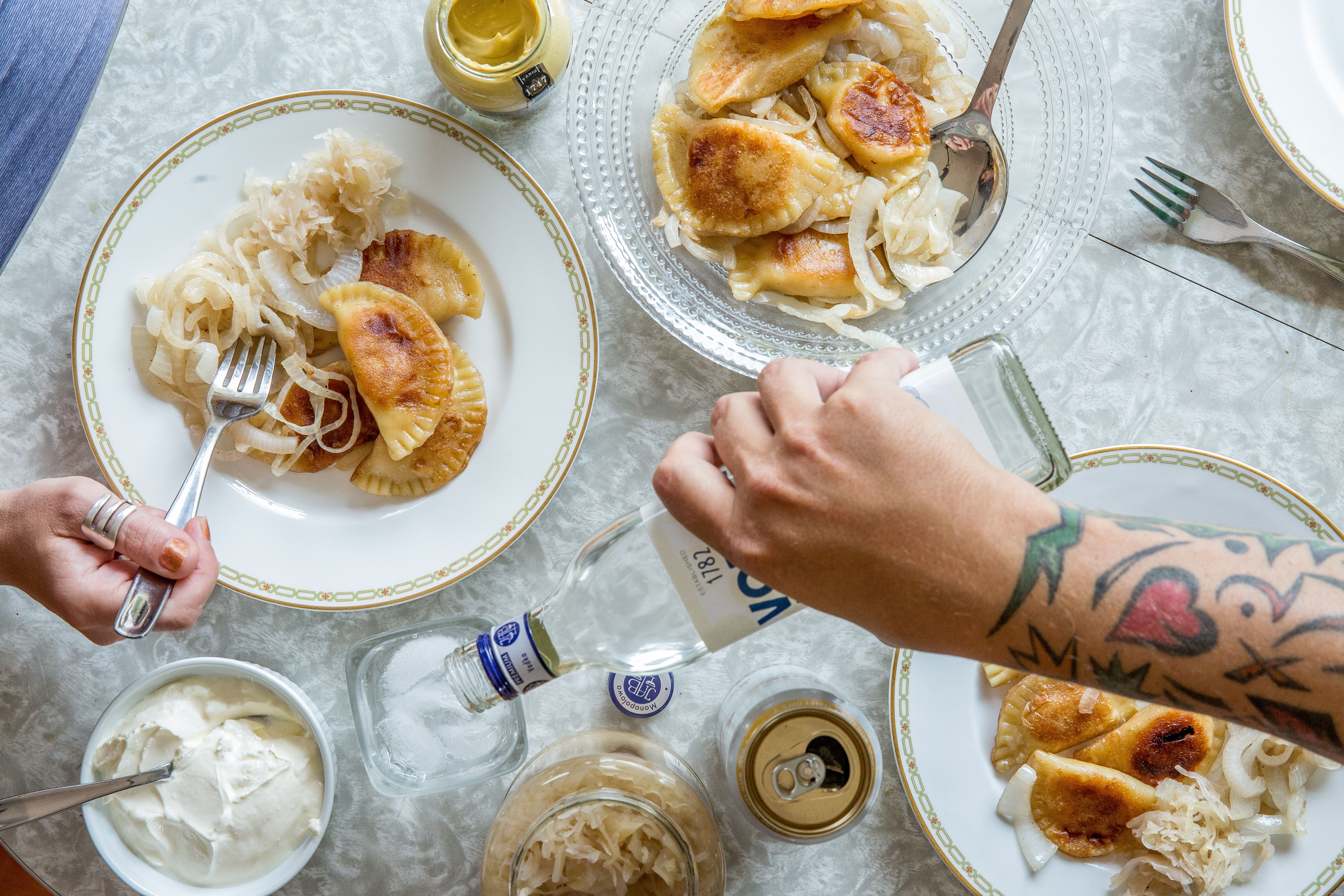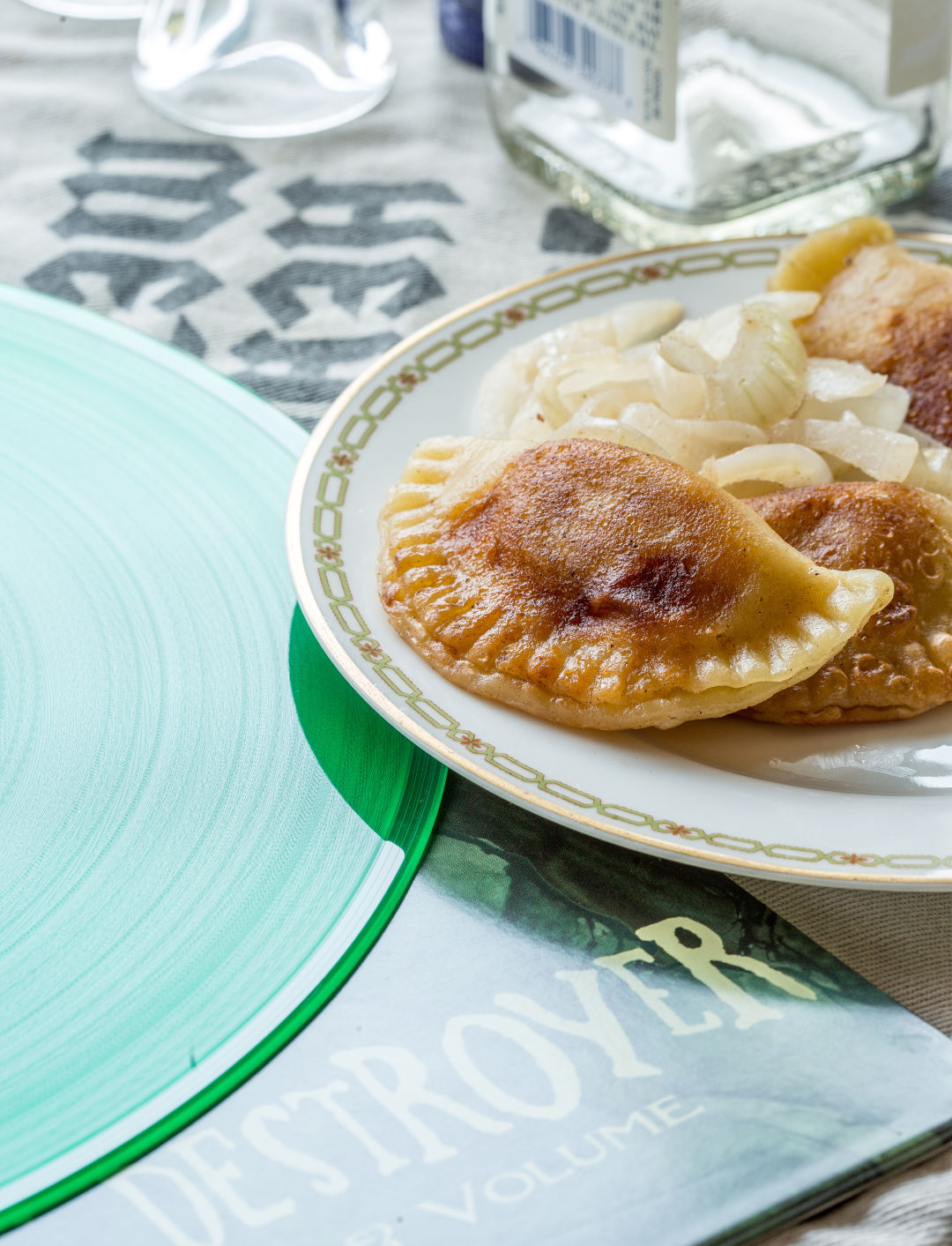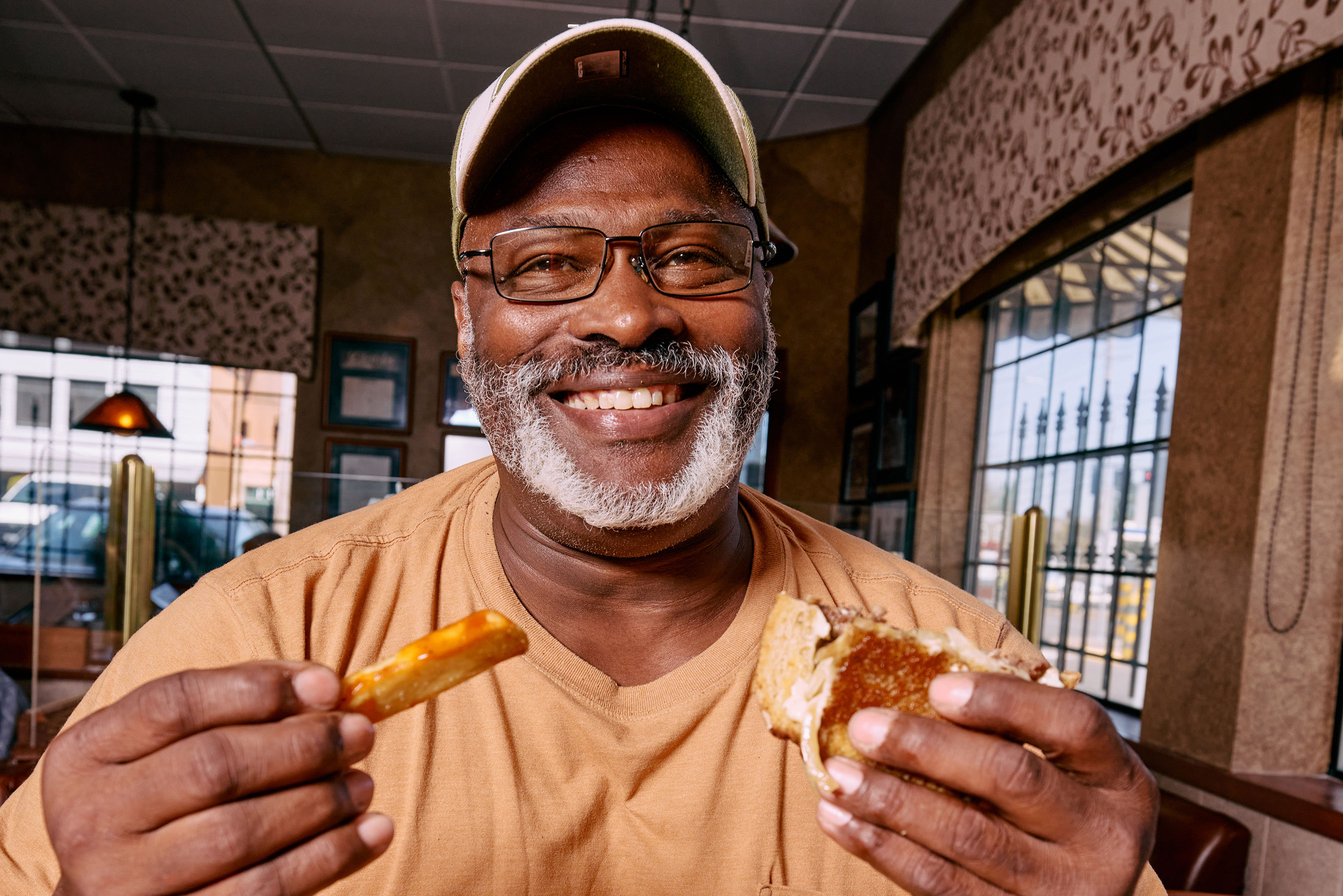
You, Too, Can Make the Pierogi of Portland Punk Legend and Lore
If you never got to hang out at North Lombard dive bar the Foggy Notion, you missed out. Punk, metal, and experimental rock bands like Nasalrod, Fruit of the Legion of Loom, and the Pathogens played the bar’s scrappy little stage, while a tight-knit crew of neighborhood beer-drinking, pinball and Skee-Ball-loving folks occupied the tables. OK, maybe missing those things is not all that sad for you—depends on who you are. What is most regrettable, however: you did not get to try Foggy Notion owners Kevin Scullin and Melanie Brandy’s scratch potato, cheese, and caramelized onion pierogi.
Not your typical dive fare, we know.
Both born back east in the Rust Belt, Scullin and Brandy opened the Foggy Notion (named after a Velvet Underground song) in 2010. From day one, the couple’s hand-formed and fork-crimped pierogi graced the menu just once a week, served with a mound of crunchy sauerkraut alongside heaping spoonfuls of sour cream and Dijon.
“We wanted to put something on the menu that was a piece of our past, for sure, but it was also, honestly, a little bit of a punk rock fuck you to gluten-free, clean-eating Portland,” explains Brandy, 48, who is small in stature but big in personality, and whose hair often changes color with the seasons. “It was us saying: ‘We know you say that you don’t want it, but we’re going to feed you tons of butter and starch and you’re going to love it.’” It worked.
The Foggy Notion was closed on Mondays, so Scullin and Brandy spent that evening prepping the pierogi. They’d start making the plump, starchy pillows at 7 p.m., have dinner as the dough rested and the filling cooled, and wrap it all up at around midnight. Typically, they’d sell out of the potato-stuffed treasures on Tuesday night. If Wednesday’s trivia-night folks were lucky, there would still be a few servings left for them.

The Foggy Notion’s Melanie Brandy and Kevin Scullin
Image: Courtesy Kevin Scullin
Brandy grew up in Pittsburgh, which some would call the pierogi capital of America. (There’s an annual Pittsburgh Pierogi Festival, held at the two-century-old Kennywood amusement park.) When she was growing up, her family—nine kids total, six of them brothers—got their pierogi fix at their local Catholic church’s festivals and dinners; the congregation’s older Ukrainian, Slovakian, and Polish women would cook the Eastern Europe–born dumplings.
Scullin grew up a couple hours northwest of Brandy in Cleveland, where he devoured the goods at old-school, cafeteria-style Polish restaurant Sokolowski’s University Inn. “Growing up there weren’t 20 options for them like there are now back East,” remembers Scullin. “It was pretty much four types: mushroom, kielbasa, potato-cheese, or potato-sauerkraut. Like Mel, my family always went for the potato-cheese.”
The Foggy’s Tuesday pierogi following was loyal and hungry. Restaurant pierogi tend to be meek and mild and, in Portland kitchens, often come from a frozen bag. The Foggy’s pierogi were a revelation; a swift kick of caramelized onion and sharp cheddar cradled in tender, sour cream–enriched dough. One bite, and Great Lakes transplants (the Cleveland, Chicago, and Milwaukee-reared) and newbies were hooked. Over the course of five years, Scullin and Brandy estimate they rolled out, stuffed, and panfried more than 18,000 potato pierogi. (One time they experimented with making kielbasa ones. It didn’t go well.)
And then, suddenly, they were gone. Scullin and Brandy shuttered the bar at the end of 2015 due to financial troubles, leaving behind only empty plates and dueling accounts of who got the last order. (Your dumpling-loving author here is, in fact, one who proudly lays claim.) The record cover-lined space has since reopened as the Lombard Pub, or LP.
So what happens to all of these Portlanders suddenly left without their dough fix? They grieve. Then, they band together and plead. This past spring, after the Foggy had been closed for more than a year, and after significant prodding, the couple invited a handful of their most loyal dumpling partisans to their North Portland home for a Foggy pierogi resurrection.
Scullin, who cohosts a weekly XRAY.FM heavy metal radio show dubbed “Strike of Death,” donned his black “Heavy Metals” apron for the occasion, Brandy broke out a growler of Commons Urban Farmhouse Ale, and the pair took us through every step.
It turns out the best way to make pierogi is, in fact, at a (raucous, drinks-flowing) party. That makes sense, considering that the dumplings have historically been a celebration food. In Poland families even make special pierogi particular to various feast days, filled with seasonal offerings. Pierogi require a lot of steps, perfect for a crowded kitchen assembly line, and each task is uncomplicated enough, beyond the attention needed to fill and crimp the dough pockets. In other words, don’t worry—you can sip on your beer, shoot the breeze, and not worry about botching anything too terribly. You can even cut out the pierogi skins with the top of a cocktail shaker. (Check out the second step in “Form the Pierogi.”) Bonus: though traditionally pierogi skins are made with leavened dough, there’s no proofing involved with this recipe. So the party won’t be an all-nighter unless you want it to be.
Once we had formed our pierogi and sautéed them with grips of sliced onion and a lot of butter (“This dish is all about the butter,” Scullin reminded us), we quickly moved into the dining room, ’70s British band the Damned cranked up on the stereo. With beers in hand, we bumped into one another more than a few times, laughing, gathering plates and chairs, scooping sour cream, Dijon, and kraut into bowls, and grabbing the significantly lightened growlers of beer for the table. When we finally sat down to our well-earned, late-night feast, we reminisced about the Foggy for a bit and how much we all still miss it. Our salve was right there on the table: crisp and golden on the outside, soft and steamy on the inside, and handmade by us—pierogi. No memory ever tasted better.

Image: Stuart Mullenberg
Kevin & Mel’s Foggy Notion Potato Pierogi
Makes 20–24 pierogi, serves 4–6
Filling
- 1¼ lbs red potatoes, peeled and cut into 2-inch cubes
- 1 tbsp canola oil
- 1 tbsp unsalted butter
- 1 cup yellow onion (about ½ of a medium onion), small diced
- ⅓ cup grated sharp cheddar cheese
- Kosher salt
- Freshly ground black pepper
Dough
- 2 cups all-purpose flour, plus more for dusting
- 1 tbsp kosher salt
- 4 tbsp cold unsalted butter, cut into ½-inch cubes
- 1 large egg
- ½ cup sour cream
Cooking & Serving
- 1–1½ sticks unsalted butter, for panfrying
- 1–2 medium yellow onions, sliced
- Dijon mustard, sour cream, and your favorite sauerkraut
MAKE THE FILLING Fill a large pot three-quarters full with lightly salted water and bring to a boil over high heat. Add potatoes and boil for about 15 minutes, until they are mashed-potato soft. Strain and set aside.
While the potatoes are boiling, melt oil and butter in a medium sauté pan over medium heat. Once melted, add onions with a pinch of salt and pepper and cook, stirring occasionally, until translucent and a bit caramelized. Cooking the onions should take about as long as boiling the potatoes.
In a medium bowl mash potatoes by hand with cooked onion and a couple pinches each of salt and ground pepper. Once it’s at mashed-potato consistency add cheddar, and stir until cheese is fully incorporated and melted.
Put bowl, uncovered, into refrigerator to cool completely before filling the pierogi. Every 10 minutes or so, give it a stir to help open up any heat pockets. It usually takes about 45 minutes to cool.
Start the dough while potatoes and onions are on the stove. In the bowl of a stand mixer fitted with the hook attachment, combine flour and salt, and mix for 30 seconds.
Add cold, cubed butter in a few batches, while mixing on medium-low for 3–4 minutes per batch, until butter is completely incorporated. Lift hook and stir a bit after each round. Once finished, scrape down the sides of the mixing bowl with a rubber spatula.
Increase speed to medium, add egg and sour cream, and, scraping down the sides of the bowl once or twice, continue mixing 3–4 minutes, until dough forms a ball around the hook. Remove from mixer.
Dust work surface with flour, turn out dough, and knead a few times. Wrap in plastic and let rest in refrigerator until filling is cooled.
FORM THE PIEROGI Lightly dust work surface with flour and roll out rested dough, flipping it a few times. Roll into a rounded rectangle, less than ¼-inch thick. You want the dough to be like a fairly thin pizza crust you cannot see your fingers through. (According to Scullin, “It’s OK if you see fold marks in the dough; that’s how you know that they’re homemade.”)
Use a cocktail shaker or a 3-inch round cookie cutter to cut out the pierogi circles. Keep cut skins lightly dusted with flour and separate enough from one another so they don’t stick together.
Combine leftover dough and roll it out to cut a couple more times. Don’t roll out more than three times, though, because dough will lose its pliability.
Using a standard melon baller or your hands, make a 1-inch wide ball of the cooled potato-onion-cheese mixture and place it in the middle of a pierogi skin. (Alternatively, if you want to be streamlined you or your group can form all of the potato mix into balls and then fill all of the skins at once.)
Carefully hand-form the pierogi into a half circle by folding it over the ball and pulling the edges out a bit to pinch them together. Push down on the round potato-filled belly slightly so it isn’t too bulbous. (This makes it easier to slightly brown all of the pierogi’s surface area later.)
Using the tines of a fork dusted in flour, crimp the rounded edge by pressing down into the seam from one end to the other. Place the formed pierogi onto a platter, making sure the pierogi aren’t touching each other.
BOIL, PANFRY, AND SERVE Fill a large bowl with ice and 1 quart cold water.
Fill a large pot three-quarters full with lightly salted water and bring to a boil over high heat. Boil the pierogi in batches of 4 or 5 for 30 seconds each. (Use a small strainer to hold them in the boiling water if you have one.) Remove from boiling water with strainer or slotted spoon, and place in ice bath for 30 seconds. Replace the ice as it melts.
Remove pierogi from ice bath with a slotted spoon and place on a paper towel–lined platter. At this point, you can either carry on to the next step and panfry the pierogi or let them cool and then keep them covered in the fridge, not touching, for up to 4 days.
In a large sauté pan over medium-low heat, melt 1–2 tbsp butter until the butter starts to bubble. Add 4–5 pierogi with some space around each, and fry, flipping them 2–3 times, for 3–4 minutes or until they are starting to get nicely golden all over. Make sure every part of every pierogi gets lightly browned, even the base, or the skin will be doughy.
Once the pierogi start to brown, lower the heat slightly and add about ¼ of the sliced onions. Cook the onions with the pierogi for about 5 minutes. Keep finished pierogi on a warmed dish in the oven while you cook the rest.
Serve immediately, pouring the remaining browned butter over the top of the pierogi, with sour cream, Dijon mustard, and sauerkraut at the table to pass.
To soundtrack your pierogi party, Kevin Scullin recommends:
- Any of the first 4 albums by Black Sabbath
- The Bleeding by Cannibal Corpse
- Reign in Blood by Slayer
- Pierced from Within by Suffocation
- Prowler in the Yard by Pig Destroyer
- Deicide by Deicide
- Lethal Legacy by Mastery




